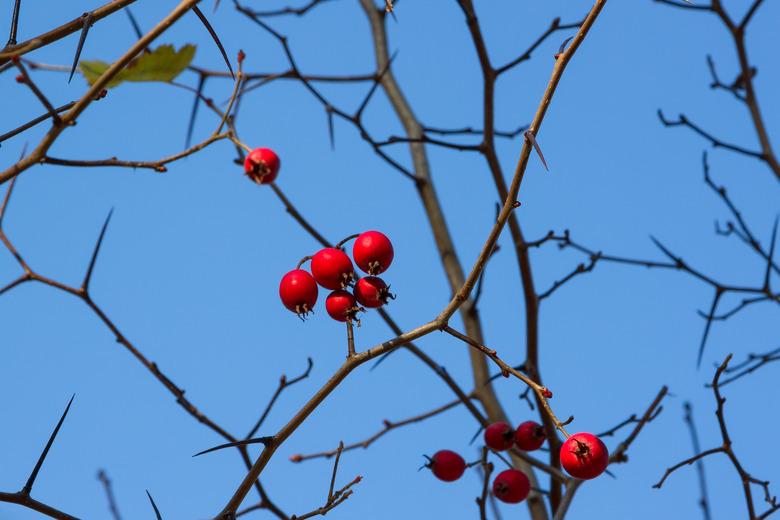List Of Plants With Thorns
Thorny plants grow the sharp and often painful spikes for their own protection, but they can also protect your home. Strategically placing plants that grow thorns in your landscaping can discourage would-be burglars from reaching your home without some serious scratches. But if you have kids or pets, knowing which plants have thorns is also important for safety reasons to prevent injuries.
Basics of Thorns
Thorns are sharp pointy projections from the branch of a plant. The purpose of the thorns is to protect the plant from being eaten by a local herbivore. Species with thorns often have showy flowers or bright berries on them, so they look attractive while packing a painful punch.
The list of plants with thorns suitable for landscaping purposes is extensive and includes broadleaf evergreens, perennials, deciduous shrubs and trees. These species include many types non-native to North America but adapted to some of the U.S. Department of Agriculture plant hardiness zones.
Trees With Thorns
Hawthorn trees have a reputation for possessing sharp thorns on their branches. Species such as the scarlet hawthorn (Crataegus coccinea, USDA zones 4-7) feature horizontal limbs armed with 2-inch spines. Pruning these trees becomes difficult due to the thorns, but hawthorns offer spring flowers and excellent fall color as a rule, making them worth the effort.
Other trees with thorns include the honey locust (Gleditsia triacanthos, zones 3-8), Osage orange (Maclura pomifera, zones 4-9) and the wild plum (Prunus americana, zones 5-9), which are all native types. An example of a non-native thorny species is the common jujube tree (Ziziphus jujuba, zones 7-10). If you have trees with thorns in your landscaping, you can prevent injury by pruning the thorn-covered branches above head level.
Thorny Perennial Plants
Thistles (Cirsium spp.), are annual or perennial plants with spiny leaves. Some have flowers that resemble those of snapdragons. Thorns are present on perennials such as the prickly pear (Opuntia spp.) and sea holly (Eryngium planum, zones 5-9). Sea holly has spiny bracts shaped like eggs that surround the flowers. They're purple-blue and bloom all summer. The asparagus fern (Asparagus densiflorus, zones 9-11) is not a true fern but this perennial has evergreen foliage and small thorns.
Deciduous Shrubs With Thorns
Thorny shrubs make a good barrier around your home as a security feature. Many types of thorny bushes can be trimmed into a hedge. They often bloom with pretty flowers to add curb appeal to your home, making this security component attractive and functional.
One characteristic of many types of roses (Rosa spp.) is their small thorns, which are actually sharp structures called "prickles." These plants come in many sizes, shapes, and flower colors, making them a versatile landscaping option.
Other deciduous shrubs with thorns include raspberry bushes (Rubus spp.), Japanese barberry (Berberis thunbergii, zones 4-8), Chickasaw plum (Prunus angustifolia, zones 5-8), and scarlet firethorn (Pyracantha coccinea, zones 5-9). The hardy orange (Citrus trifoliata) has extensive, sharp thorns, making it fit as a barrier plant or hedge in USDA zones 5 through 9.
Other Thorny Plants
The prickly poppy (Argemone mexicana, zones 7-10) from the western United States has showy flowers, and it also has sharp thorny prickles. Broadleaf evergreen species such as the pigeon berry (Duranta erecta, zones 9-11), is another thorny plant landscapers value for its foliage, flowers and fruiting ability.
Some vines, including bougainvillea (Bougainvillea spp., zones 9-11) and wild sarsaparilla (Smilax glauca, zones 4-10), have thorns, as well. Bougainvillea has its thorns along the stems where the leaves grow out.
